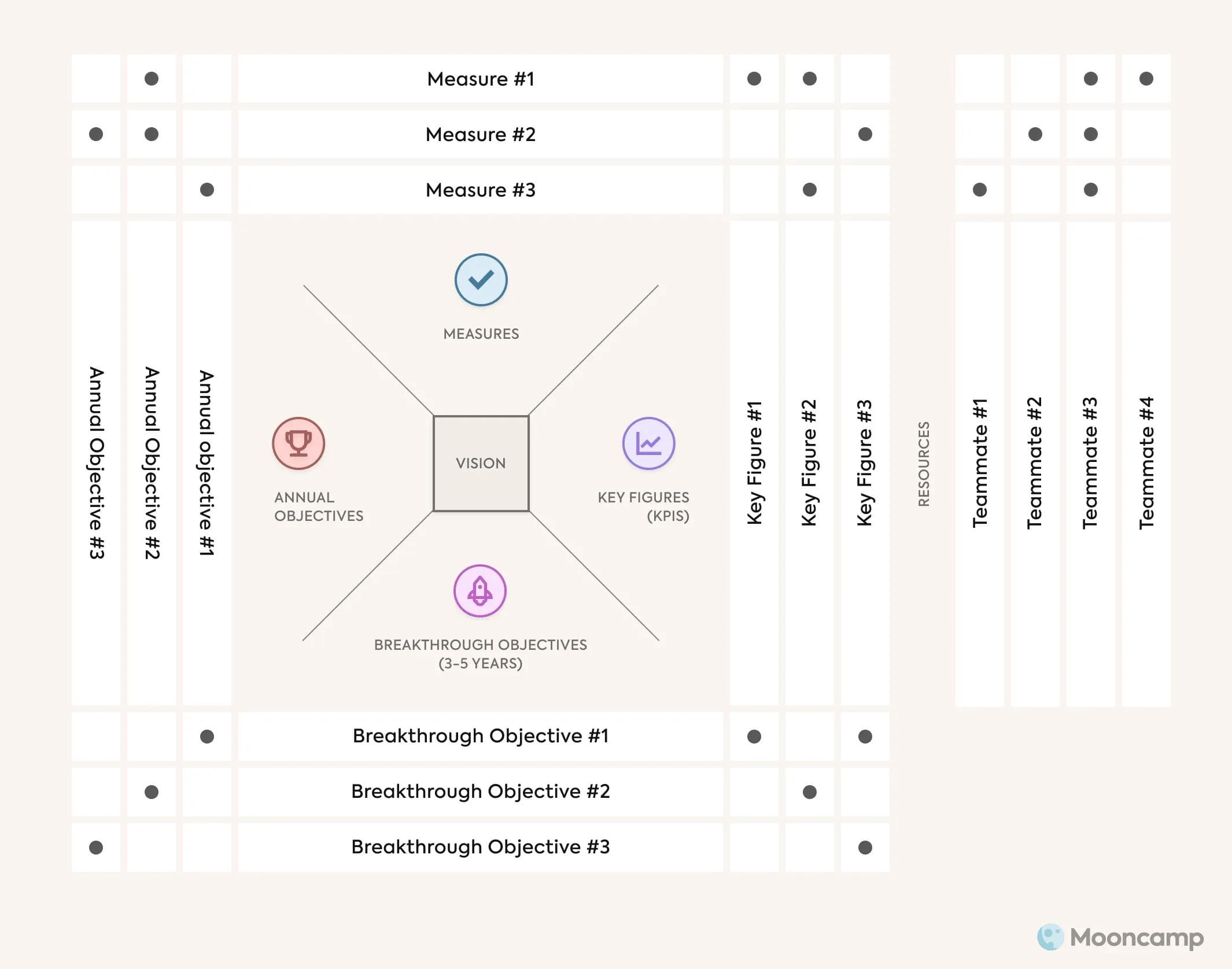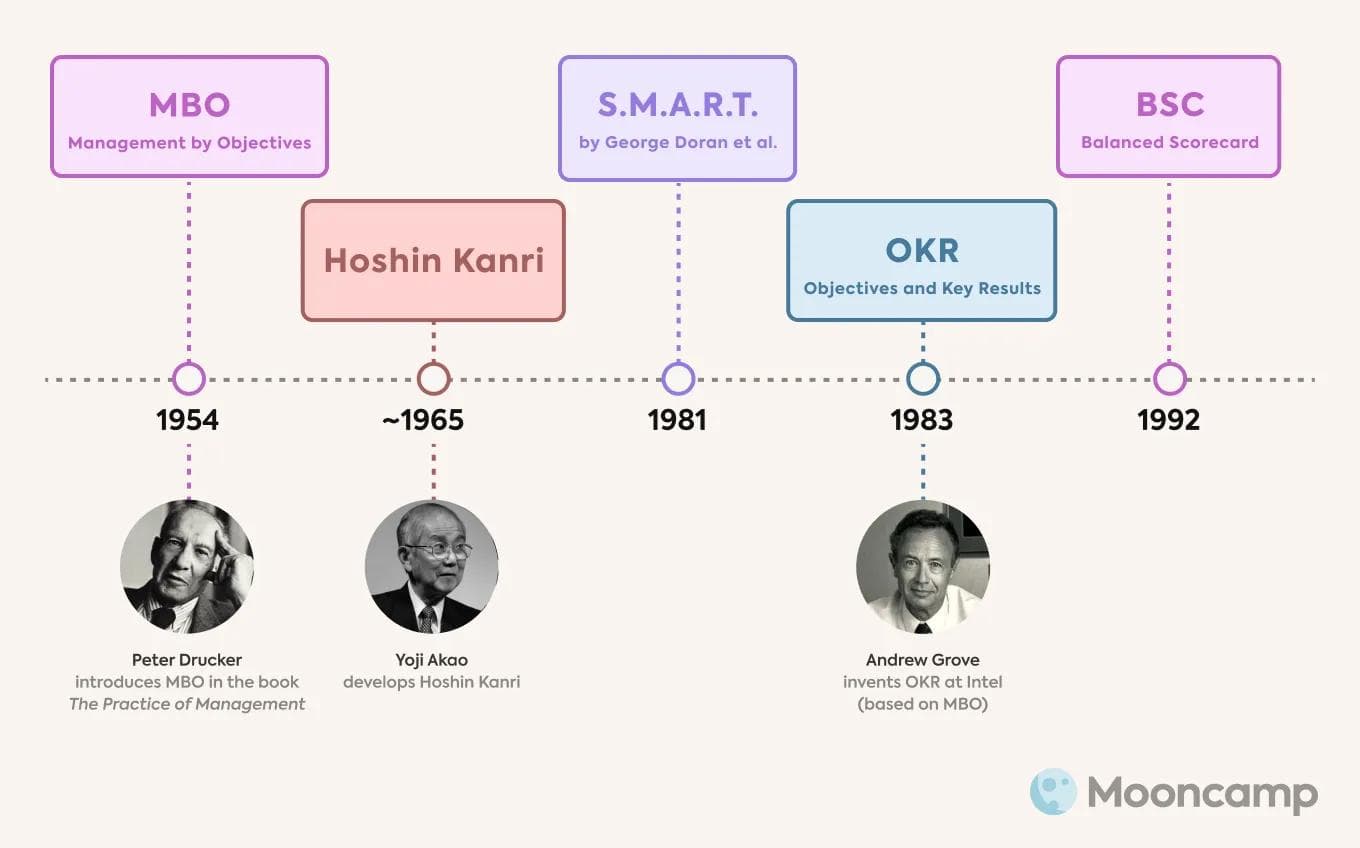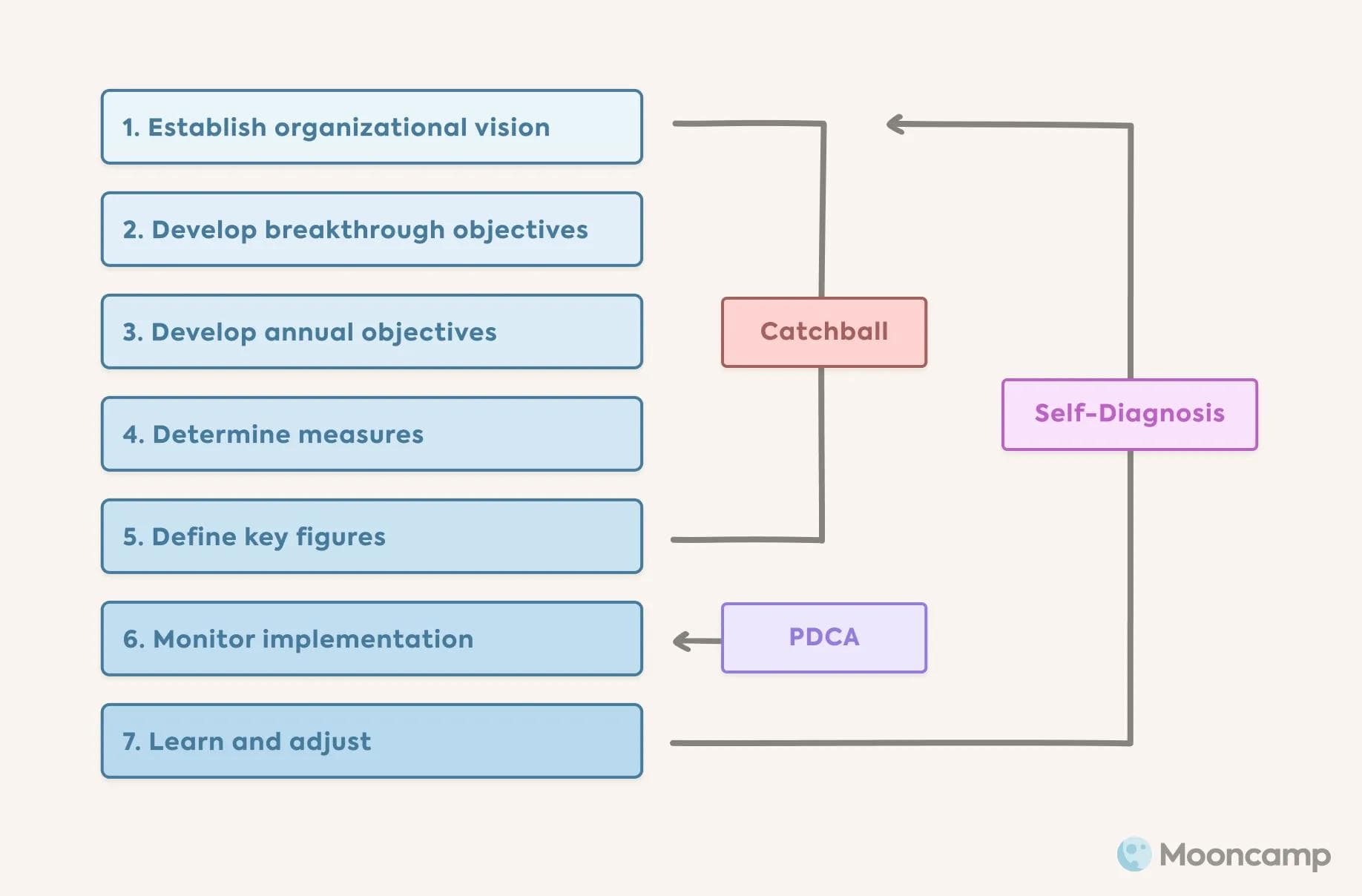Hoshin Kanri: The secret behind the Japanese management method

Once a company has defined its visions and strategic objectives, they also have to implement them. For this to succeed, you need a clear strategic plan that all employees can understand. One way to create such a plan is Hoshin Kanri – a Japanese management method that displays a company's vision, strategies and goals in a concise matrix.
In this article, we take a closer look at how exactly the Hoshin Kanri method works, what “Hoshin Kanri” actually means, and how the Hoshin Kanri matrix can be combined with other methods.
What to expect:
- What is Hoshin Kanri? Definition
- How the Hoshin Kanri method works – 7 steps
- Visualization with the Hoshin Kanri matrix
- What can Hoshin Kanri offer? Advantages and disadvantages
- Practical tips: Combine Hoshin Kanri with other methods
- Conclusion: Effective tool for visualization
- Hoshin Kanri – FAQ
What is Hoshin Kanri? Definition
The term Hoshin Kanri originates from Japanese and consists of several elements: “Hoshi” stands for “star” or “compass needle”, “Hoshin" for “strategy” and “Kanri” means “management”. Fully translated, Hoshin Kanri means something like “compass management”, i.e. the strategic orientation towards a certain goal. The method is also known as Policy Deployment or Management by Policy.
As a method for implementing a company-wide strategy, Hoshin Kanri is neither new or spectacular, but it is simple and practical. What makes it special is that Hoshin Kanri combines a classic top-down approach with bottom-up elements from lean management.
Top management develops a vision and strategy for the entire company and passes these on as goals to be achieved through all hierarchical levels. The employees then implement them in a self-guided manner. All teams regularly check whether they are achieving their goals and how they can improve further. They then pass on their suggestions for improvement to their managers.
The goal of Hoshin Kanri is that, in the end, everyone pulls together and works toward the company's strategy and goals.

Core elements of Hoshin Kanri
The idea behind Hoshin Kanri comes from lean management. It is about getting the most out of a company's resources with continuous improvement.
In addition, Hoshin Kanri also incorporates elements of Kaizen, a Japanese philosophy of life and work that always strives for improvement everywhere.
In terms of leadership, Hoshin Kanri builds on the 4C model and requires from decision-makers:
- Clarity
- Courage
- Commitment (in the sense of understanding purpose)
- Consensus (in the sense of a shared understanding of priorities and ideas on how to involve employees)
How the Hoshin Kanri method works – 7 steps
Like other methods for strategic management, Hoshin Kanri is not a one-time action, but an ongoing process. The Hoshin Kanri planning process consists of seven steps:
1. Establish organizational vision
The Hoshin planning process always begins with the top management defining a corporate vision. The vision indicates what the company stands for, which values it embodies, or what it wants to achieve in the long term. For example, such a vision might read:
2. Develop breakthrough objectives
The next step is to then break down the company vision into smaller, intermediate strategic goals – so-called breakthrough objectives. By this, we mean concrete objectives for the next three to five years. To ensure that they remain as practical as possible, these are ideally not developed by top or senior management alone, but together with middle management. The purpose of the breakthrough objectives is to make the vision more comprehensible and tangible.
3. Develop annual objectives
Next, things are put into even more concrete terms: The company's annual objectives are defined. In most cases, these are sub-goals from the previously defined breakthrough objectives. This step answers the question: How far do we want to get this year? What is important here is that this is done on a cross-departmental and cross-divisional basis, and that these annual objectives are also jointly created by a leadership team that consists of senior managers, middle managers and team leaders.
4. Determine measures
Putting goals into practice requires concrete measures. With Hoshin Kanri, these are not completely prescribed from the top down, but are worked out in collaboration with the employees. This ensures that the measures are actually practicable.
5. Define key figures
Together with the measures, one also defines key figures that record whether these have the desired effect and the goals are achieved. It makes sense to not only include traditional performance indicators (e.g., sales, quality, or productivity), but also process indicators (e.g., error rate) and metrics such as customer satisfaction or brand awareness.
6. Monitor implementation
Simply implementing strategies and measures is not enough. Regular checks should also be made to ensure that everyone is on the right track as they implement annual objectives. How this is done and at what intervals can vary. Some goals take time and can only be monitored after a few months; for others, it makes sense to review earlier whether you are still moving in the right direction.
7. Learn and adjust
After some time, usually at the end of the year, the company takes stock once again on a grand scale: Were the short- and medium-term strategic goals achieved? Where do we stand on the way to our long-term goals? What went well, what should still be optimized? And what can we learn from this as a company as a whole? The results of the analysis are then used to take corrective actions for next year's strategic plan.

Special features in the Hoshin planning process
Hoshin Kanri does not work strictly hierarchically. This results in two additional special features for the process: the catchball and the PDCA cycle.
Hoshin Kanri catchball
Figuratively speaking, employees repeatedly throw the catchball to their managers throughout the entire Hoshin Kanri process – namely, by giving feedback to management in the form of criticism and suggestions for improvement.
In this way, managers can see whether their actions make sense and can actually be implemented – and whether all employees have understood what they are supposed to do.
PDCA model
The PDCA model helps to implement Hoshin Kanri in the company. It is a technique for continuous improvement that is also used, for example, in methods such as Scrum or Management by Objectives (MBO). Within the seven steps of Hoshin Kanri, it is applied to control the implementation of the measures.
The four letters stand for four phases: Plan, Do, Check and Act. This means: Within a PDCA cycle, goals are set in short stages (for example on a monthly basis) (Plan). These are implemented with concrete measures (Do). Then it is checked whether the goals have been achieved (Check). Depending on the results of the check, the course is maintained or corrected with new measures (Act).
Visualization with the Hoshin Kanri matrix
Graphically, the Japanese management method is implemented in the form of a matrix – which somewhat resembles a compass:
- The company vision sits in the middle, acting as the basis for the compass needle, so to speak.
- The measures and strategies that leaders derive from the vision are in the north.
- The south consists of long-term and medium-term planning, i.e. the company's goals for the next three to five years.
- In the west, the short-term goals (usually for one year) are recorded.
- Opposite them in the east are the corresponding key figures.

The Hoshin Kanri matrix (also Hoshin Kanri x-matrix) is designed to help everyone in the company understand where the journey is headed and why individual actions make sense. The matrix is never firmly set in stone, but employees can influence and co-determine the direction to a certain degree.
What can Hoshin Kanri offer? Pros and cons
When implemented correctly, Hoshin Kanri bridges the gap between strategy and execution. At the same time, however, the management method also presents decision-makers with a number of challenges.
We have summarized the most important pros and cons of Hoshin Kanri here.
The pros:
✔️ Hoshin Kanri helps an organization to focus and visualize corporate goals.
✔️ Rigid hierarchical processes are broken up with agile elements. Companies can thus act more flexibly.
✔️ Visualization makes it easy to communicate the corporate strategy.
✔️ The concept can be used flexibly, regardless of the size of the company.
The cons:
❌ Hoshin Kanri does not prevent the formulation of false or unrealistic goals.
❌ Competition and environmental factors play no role in the technique and are ignored.
❌ Hoshin Kanri only provides a framework for visualization and an outline of the process. How exactly goals are defined and formulated is not specified.
❌ Goals are formulated for one year. In our modern, fast-paced world of work, this planning period may be too long.
Practical tips: Combine Hoshin Kanri with other methods
The weaknesses of Hoshin Kanri can be well compensated by combining the technique with other (agile) methods or by providing the Hoshin Matrix with additional info. For example, one could:
- include responsibilities and timelines for actions in the matrix.
- assign each breakthrough and annual objective to different categories or perspectives and develop the matrix into a Balanced Scorecard (BSC) resp. Strategy Map.
- formulate each annual and breakthrough objective using the SMART goals method.
- use OKRs to further break down the annual goals and focus on specific objectives for a certain period of time (usually quarterly) during implementation. The right OKR software can help with this.
Hoshin Kanri vs. OKR – similarities and differences
At this point, it is worth taking a closer look at the topic of OKR vs. Hoshin Kanri or the combination of the two methods. In fact, OKRs (short for “Objectives and Key Results”) and Hoshin Kanri have some things in common:
- Both methods aim to create alignment and transparency, and to enable employees to contribute to the company's goals through **self-directed work. **
- Both Hoshin Kanri and OKRs function as an iterative process.
However, they also differ in two important ways: Complexity and time. Whereas Hoshin Kanri typically involves setting goals at multiple levels and establishing a holistic, overarching strategy for the entire organization over several years, OKRs focus on specific goals for a shorter period of three to four months. In addition, OKRs are leaner and exclusively outcome-focused.
💡 Tip: If you want to read more on the topic of OKRs or refresh your knowledge, simply take a look at our OKR Guide or browse through our blog.
The fact that OKRs work with shorter periods of time opens up the above mentioned combination possibilities with the Hoshin Kanri method.
💡 By the way, there are other strategic frameworks that can promote a company's success through strategic targets. In addition to Hoshin Kanri and OKR, it is also worth taking a look at MBO, OGSM, and Balanced Scorecard.
Conclusion: Effective tool for visualization
Companies need a well thought-out strategy to be successful in the long term. At the same time, they need to remain flexible and be able to react to changes in the working world. Hoshin Kanri can unite these two requirements in strategic planning by breaking down rigid hierarchical processes with agile elements and bringing management into a continuous dialogue with employees.
However, the planning method also has some weaknesses: It visualizes strategies and provides the framework for the process, but does not regulate how exactly goals are to be formulated and identified. Therefore, in practice it makes sense to combine Hoshin Kanri (as an effective visualization tool) with other (agile) methods – for example OKRs, Balanced Scorecard or SMART.
Hoshin Kanri – FAQ
What does Hoshin Kanri mean?
The term “Hoshin Kanri” comes from Japanese and consists of several elements. Altogether it means something like “compass management” or “steering in one direction”.
What are the 7 steps of Hoshin Kanri?
Strategies are planned and implemented with Hoshin Kanri in seven steps: 1️⃣ Formulate vision, 2️⃣ set breakthrough objectives, 3️⃣ set annual objectives, 4️⃣ determine measures, 5️⃣ define key figures, 6️⃣ monitor implementation and 7️⃣ learn and adapt.
Why do companies need Hoshin Kanri?
Hoshin Kanri can be used flexibly and helps organizations of all sizes to focus, visualize business goals and communicate them to employees in a simple and understandable way.
